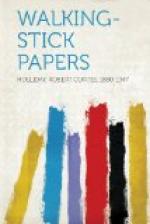Hello, there’s Mr. Chase! And that’s a fortunate thing, too, as no sympathetic picture of a representative American art exhibition should omit Mr. Chase. Whether or not we think of him as our premier painter, we should be inordinately proud of him. Undoubtedly he is a great artist. He has wrought himself in the grand manner. In person he delights the eye, and satisfies the imagination. With his inevitable top-hat, his heavy eye-glasses cord, his military moustaches and upward pointing beard, his pouter-pigeon carriage, his glowing spats and his boutonniere, his aroma of distinction, and his ruddy consciousness of his prestige, he is our great tour-de-force as a figure in the artistic scene. He is here, naturally, now the target of popular interest.
The practice of having artists shown at their own exhibitions is one too little cultivated. The Napoleonic brow and the Napoleonic forelock (famous in their circle) of George Luks, the torrential Luksean mirth, how would not their actual presence open the spiritual eyes of visiting school-children to the humane qualities of the works of the Luksean genius! And why should we who procure for our better perception of their works illuminating biographies of the Old Masters not be permitted the intellectual stimulation of beholding the Ten American Painters seated along on a bench at their annual show? The subject of the artists themselves, however, brings us around to the line between the two kinds of people having to do with art exhibitions: fine-looking people and funny-looking people.
Come; let us trot along. Artists themselves are, in a most pronounced degree, of both kinds. And a very singular thing is this: the funnier an artist’s pictures are, the funnier-looking is the artist that made them. We’ll stop in here, at The Advanced Gallery.
“Ah! How are you?”
That, just going out, is one of the newest groups of painters, known as the Homeopathics. I used to know him before he went abroad. And the curious thing is, that at that time he was very good-looking. He was clean shaven. This strange assortment of whiskers of different fashions on various parts of his face, imperial, goatee, burnsides, he brought back with him.
Notice as we step from the car at the gallery floor the numerous others here who also were at the show we just left. And those who are thus making the rounds, you perceive, are not of what is called society, but of the kind known in these circles, doubtless, as interesting. Nearly everybody in this gallery, in fact, is of the interesting sort. At once it is apparent that there is nothing of the perfunctory here. Art is vital. Art is earnest. The atmosphere is tense. The young women are clad in a manner giving much freedom to the movement of their bodies. They walk with a stride. Their clothes are not of the mode of the Avenue, but they have—how shall I say? To twist what Whistler said of his model: Character, character is what these clothes have. They suggest, many of these young women, the type that has never got back from—




